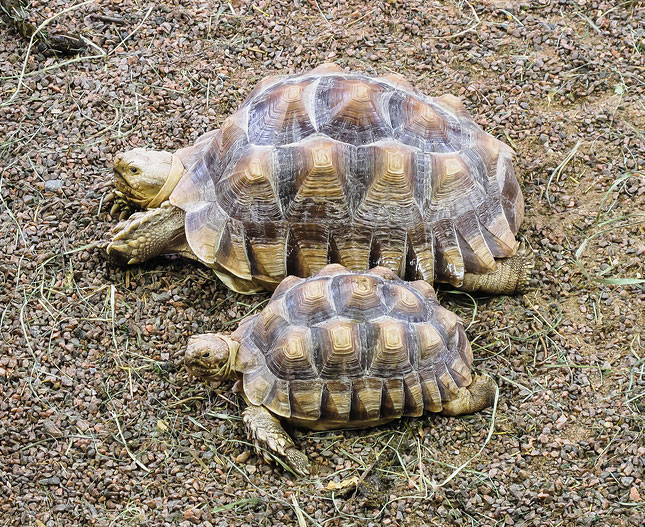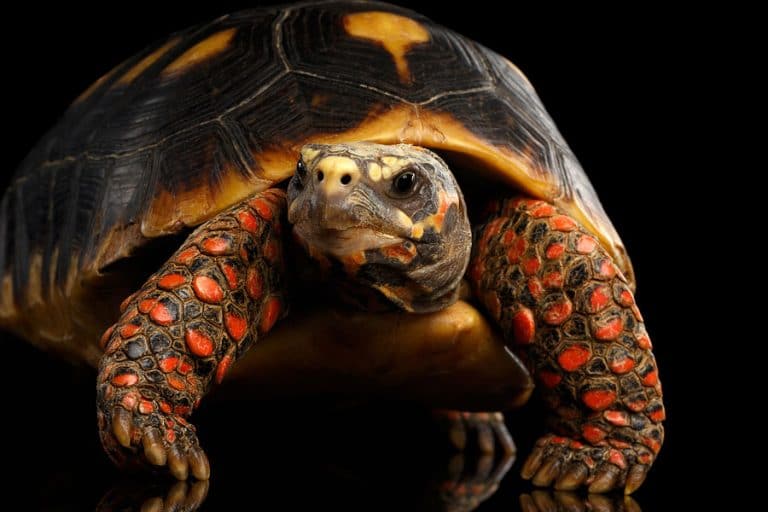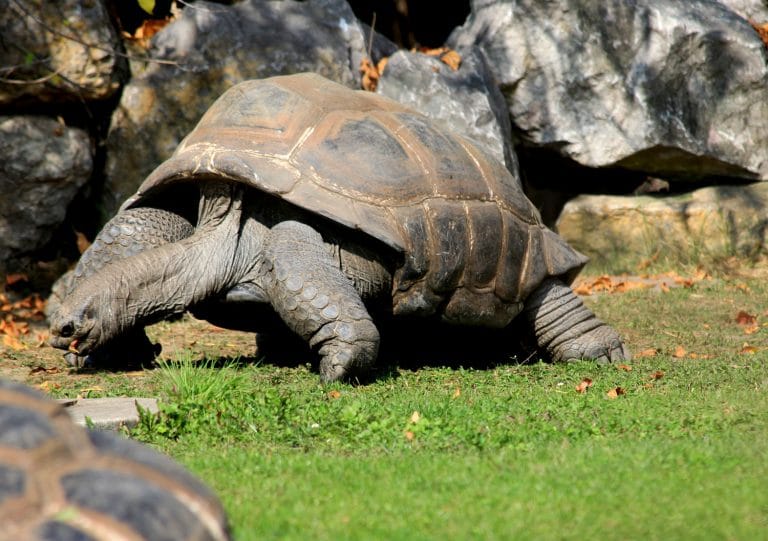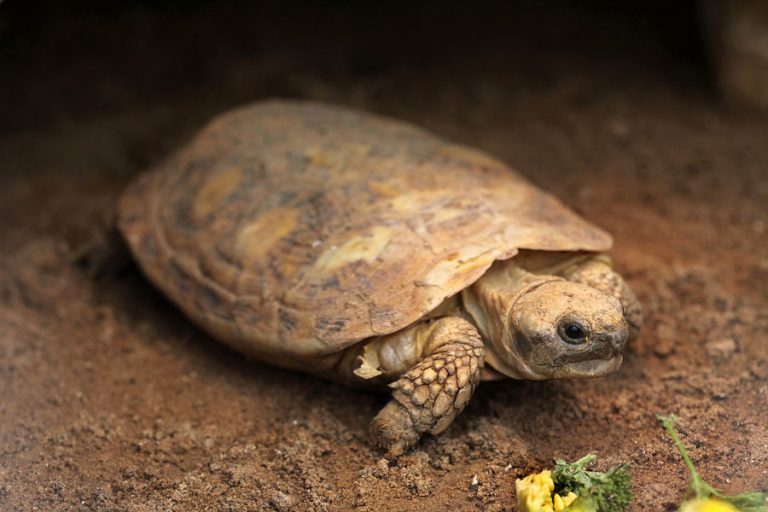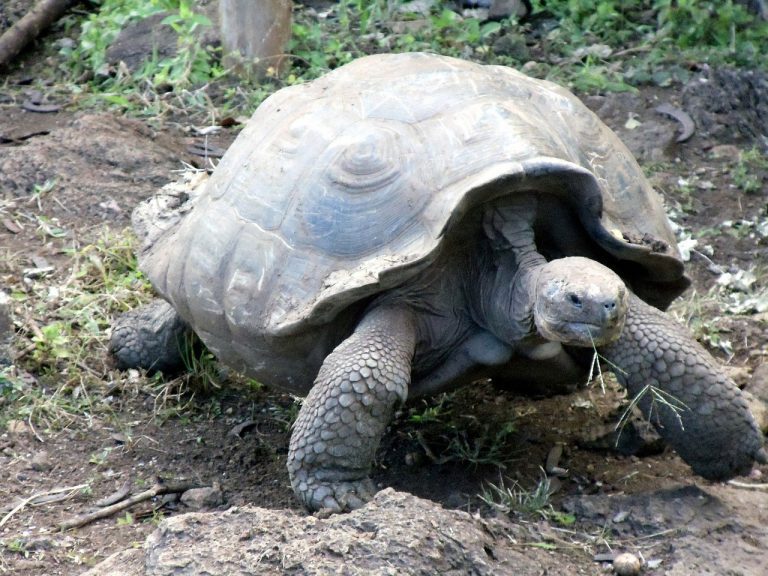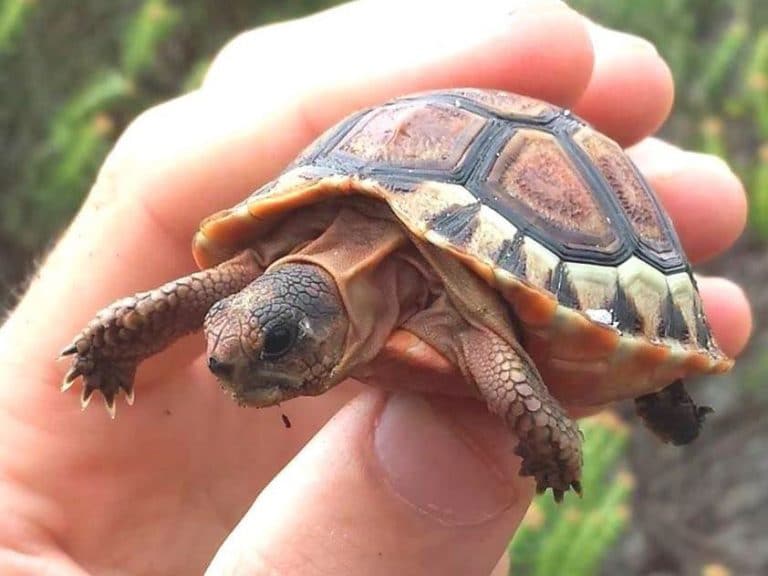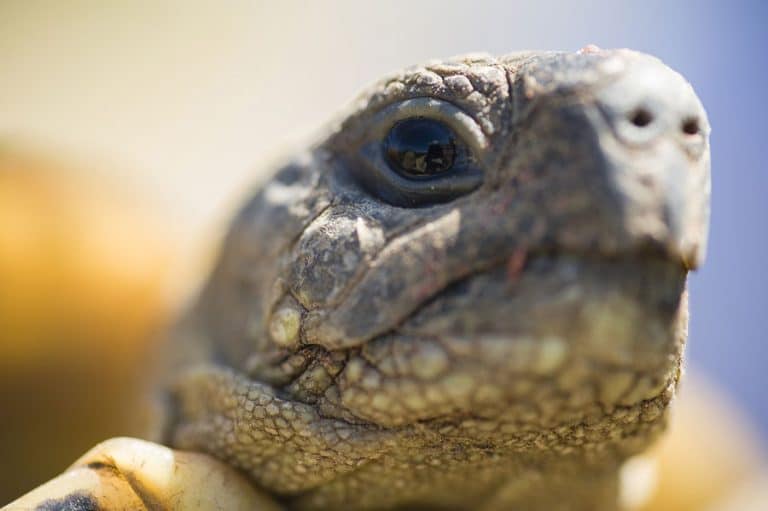Sulcata Tortoise: Breeding, Habitat, Size & Care
If you are either a pet owner or an enthusiast, it is likely that you know that sulcata tortoises can be a popular choice among your peers. That is the case especially, if you want something unconventional and out of the ordinary when picking a pet.
Certainly it is going to be a challenge taking care of pets such as tortoises, as owning one isn’t very common and might be unheard of for some. From that alone, you can easily tell that extra effort should be put for you to learn about the nature of these animals. Moreover, learning about the different dos and don’ts when having a somewhat exotic pet also requires you to do some research to ensure that your pet receives the care and attention that is due to them.
Furthermore, among the various species of tortoises, one of the most popular ones to be selected as pets are the sulcata tortoise. Also known as the African spurred, these animals are one of the biggest species of its kind on earth. They can weigh up to 43 kilos and grow up to 656 mm when fully grown.
Aside from that, they can live up to more than a century, surpassing the lifetimes of their owners. Unbelievable as it may seem, but these are all facts that prospective sulcata owners should bear in mind. So, what else is there to be known about these rather interesting creatures? Just read on if you intend to be further enlightened about this matter.
The term “sulcata” actually means “furrow” in Latin. This pertains to the furrows which can be found on a sulcata’s scales. These tortoises are a native of the Sahara Desert and the Sahel in Africa. To get to areas with higher moisture, they dig burrows which may reach up to 10 feet below the ground. They spend the warmest parts of the day in these burrows. Due to the fact that the temperatures can get really high in their habitats, they only come out whenever the temperature is just right.
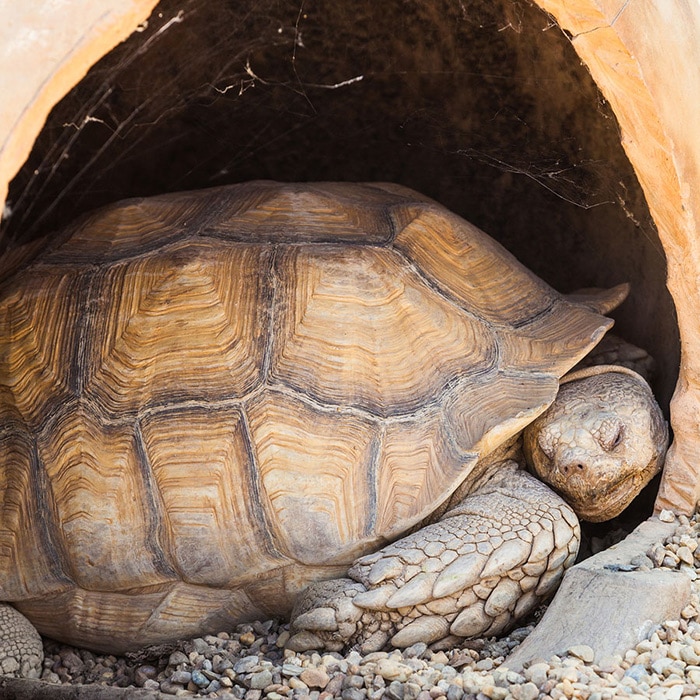
Usually, they get out during dusk and dawn when temperature levels aren’t very harsh. The African spurred tortoise is considered to be a very important part of the ecosystem that they are a part of as they are only one of the few animals that can excavate burrows thanks to their specialized claws.
Other creatures of the desert also seek shelter in the burrows that these creatures dig in order to avoid the inescapable heat that sweeps through their environment. At the bottom of these burrows, the temperatures are much more bearable, which would range from around 50 to 70 F. This is about half of the temperature on the surface.
Being an exotic pet, there are extra notes to be taken when caring for one of these creatures. In terms of housing, they should be sheltered in a dry place. Hence, it is important that they stay indoors whenever it is raining or when the weather is damp or cold. In addition, there should be a large enough space as these tortoises move around a lot. And on top of that, they are pretty much strong, so keeping them in an area with a large space will be good for them.
Even though it is ideal for them to stay in dry and warm areas, high temperatures exceeding 104 F isn’t exactly what’s recommended for them. When such is the case, they find ways for them to cool down by smearing saliva on their forearms or through burrowing. Another aspect of being a sulcata tortoise owner would be one concerning thinking of what to feed your exotic pets. It is no secret that they are voracious eaters. They should maintain a diet that consists of high fiber levels. Calcium is another part of their diet.
A lack of it may cause their shells to form an odd shape which is referred to as pyramiding. They are herbivores and giving them the right kind of food is important to ensure that they remain healthy. Remember to take note of what to feed and what not to feed them. Some important notes to remember is the fact that fiber and a grass-based diet is what it needs.
In the wild, weeds and dry grasses are the kinds of food that are readily available to them. Moreover, too much protein, sugar and fruit in their diet is not advisable. Another thing to bear in mind is the fact that they shouldn’t be overfed. While it is true that sulcatas are voracious eaters, reptiles don’t metabolize as fast as mammals, so simply give them the right amount of food.
It is no doubt that having an exotic pet on board can be both fun and exciting, there is that certain sense of fulfillment that it brings. But just as anything else that is out of the ordinary, you can expect that there are challenges that go along with it. That is, it is not an easy task, especially for beginners. That is why understanding and reviewing the nature of these creatures is a must if you ever plan to have one as a pet. If you find out that you are up to the challenge, then go for the thrill and experience how fun it can be being an owner.
Want to Adopt a Sulcata Tortoise?
Are you ready to get the third largest species of tortoise on the planet for a pet? Remember that the Sulcata, though temperamentally ideal for a pet, still require you to make them comfortable for a long stay, be it rearing them indoors or outdoors.
It is really a pity that, notwithstanding the serious efforts of the wildlife conservation groups in their conservation, poaching them from their natural habitat and distributing them to the pet shops, especially the freshly hatched ones, in the world has become a hazard of epic proportions.
Introduction
“Centrochelys Sulcata,” called the Sulcata or the African Spurred Tortoise, is endemic mainly to Northern Africa’s southern Sahara Desert’s belt and inhabits the transitional ecoregion of the Sahel that is endowed with shrubs, savannas, shrublands and grasslands that are commonly found in the countries of Sudan, Senegal, Nigeria, Mauritania, Mali, Ethiopia, Eritrea, Chad and Burkina Faso.
These animals follow a system of “aestivation” when they dig burrows ranging from 30 inches to 10 feet in the ground to reach cooler moisture levels to spend the hotter parts of the day.
You may be interested to know that the Sulcata, the sole species in the genus Centrochelys, is the third largest in the world behind the Galapagos and the Aldabra, but certainly the biggest mainland tortoise.
Adult Sulcata grow quickly from their hatching size of about 2 to 3 inches to reach an estimated size of 33 inches or 83 centimeters and weigh around 231 pounds or 105 kilograms. The oldest living Sulcata in captivity was recorded as living in Egypt’s Giza Zoological Gardens at an age of 54 years in 1986. Most estimates concur that they can live up to 70 years.
The word Sulcus was obviously derived from a Latin word sulcus that refers to “furrow”, probably those found on the species’ scale.
Diet
Providing your sulcata tortoise with a proper diet is important to ensure that they grow healthy. If they aren’t provided with the right food, they might develop health issues that will ultimately cause them to have shorter lifespans. Also, the type of food you give them can affect how their shells will be formed.
Hence, it is apparent how diet truly matters for their development. Moreover, since these animals are highly herbivorous, their diet should be high in fiber and the amount of protein given to them must be regulated. This article will provide you with the necessary know-how so that you can be prepared to help your pet grow up to be healthy.
A sulcata diet should be high in fiber and have very low amounts of protein. Some owners might make big mistakes, such as feeding their pets with high levels of protein, which is not advisable at all. What are some foods that contain a lot of protein? Some examples include dairy products, legumes and grains. A diet with high levels of proteins can cause its shell to have a pyramided form. It can also be a cause for them to have kidney and liver problems.
Hence, before you give your tortoise something that wouldn’t normally be found in their natural environment, it would be best for you to check the food’s protein content first. Another food to avoid are fruits. Fruits aren’t advisable since the acids and sugars found in fruit can cause essential bacteria found in the animal’s digestive tract to die. Losing such bacteria can be fatal to the well-being of the creature.
Feeding your pet tortoise can sure be fun. However, don’t go overboard by overfeeding your pet. Being a reptile, a sulcata’s metabolism is slow and feeding them too much isn’t recommended. The amount of food that they are given should be directly proportional to the amount of exercise they get. If their activity level is low, feeding them everyday is not required. This fact might be difficult to grasp but it is something that you should keep in mind.
So what should they eat? Imagine your tortoise in its natural environment; a dry and hot desert with an abundance of grasses, weeds, leaves and other herbaceous plants. Well, you get the idea right? They need to be fed with a high fiber diet. Also, please note that their plant diet should not have any traces of fertilizers and pesticides. Water is of the essence as well! You can place a bowl or saucer filled with water on its shelter to help them keep hydrated throughout the day.
The main diet of the Sulcata tortoises is an assortment of plants and grasses with a low content of proteins but rich in fiber content. Keep from feeding them fruits.
The ideal staple food of the matured tortoises consists of a variety of leaves and grasses, similar to their normal diet. They graze on the lawn grasses of either grape leaves, mulberry leaves flowers and hibiscus leaves. The big Sulcata consume grass hays.
The other alternative is to feed them on spring mixes (particularly while juvenile aged). These spring mixes consist of many leaf like ingredients in addition to turnip greens, collard greens, kale and some types of dark lettuce. To compensate the nutritional bases not found in many diets, the Mazuri Diet is occasionally recommended
As Pets
The Sulcata are known for their pleasing personality; in spite of their major confrontations, occasionally they are reared as pets. When in confinement, they become accustomed to different habitats and climatic changes. Many novice breeders find the Sulcata to be their favorite pets because of their docile and inquisitive demeanor.
The Sulcata need big enclosed spaces with a temperature maintained around 60 degrees Fahrenheit (16oC), and beds made of hay with a grass base. The diet of these creatures is comprised of a rich content of fibers. As such, at least 75% of their food should consist of grasses.
To keep them fit, it is mandatory to give them a good amount of calcium for the growth of their shell and bones, with reduced protein, less sugary foods, and fruits. The tortoises in the wild get sufficient calcium from the earth. Therefore, these pets need a supplement of calcium. The juveniles gain maturity within no time and during the initial 3 years; they grow to twice the size.
Most of the “wet” vegetables lead to severe health hazards; however, hibiscus leaves, prickly pear cactus pads, dandelions and hay of different grasses are normally secure. Few of the usual garden plants like the azaleas are poisonous for them. Pyramiding and malformation of the shells are caused when the content of protein is high and that of the calcium is low. The Sulcata are gluttonous and occasionally eat too much. A few of them absorb excess of proteins by consuming snails and caterpillars.
Breeding
Copulation follows immediately after the monsoons, extending from September through November. Males fight with themselves, claiming the right to breed among the females.
Two months following mating, the females go in search of a convenient place to build their nest. Within a span of 5 to 15 days, the female unearths about 4 to 5 nests, prior to choosing the apt one where they lay the eggs.
Soil that is not compact is removed from the cavity and the females often urinate into the cavity. When the cavity attains a depth of 3 to 6 in. (7 to 14 cm) and a diameter of 2 ft. (60 cm), they still excavate another 8 in. (20cm) deep, behind this cavity.
After completing excavation of the nest, the female starts laying one egg in a duration of three minutes. In a clutch, there are chances that you would find about 15 to 30 eggs or perhaps more than that. On completion of laying the eggs, the female totally covers the nest within one or more hours. It is mandatory for maintaining an incubation temperature of 86 to 88oF, for a period of 90 – 120 days.
Lighting and Temperature
Outdoors
The Sulcata tortoise reared outdoors adjust to different ranges of temperature. When the temperature is high, they have no problems if you have provided them with shelters where they take shelter in the shade. They can adjust to sudden cold temperatures of 45o F comfortably. When the temperature at night falls lower than 50 degrees, they must be provided with a heated box of temperature range 55 to 60° (70 is ideal)
Indoors
For the Sulcata tortoise that is reared as an indoor pet, a normal temperature range of 68 to 80 o is sufficient. Even for them, a convenient basking provision with an overhead lighting provision is a must. Maintain the basking place to a temperature of 100.
Similar to the majority of diurnal tortoise that are herbivorous, these also require a UVB light for the enclosures that are indoors to enable them to process their diet of calcium with ease. Maintain the enclosure with lighting facilities for a period of 12 to 14 hours during the day; at night time switch off all heat and light sources.
Sulcata Tortoise Temperament and Handling
Unlike what sellers claim, it is not normally advisable to handle a Sulcata frequently. Over-handling can easily develop stress in them. Besides, there are chances for children dropping them when they are spooked. Such stress issues end in a slowdown in their health and activities.
According to CITES, exporting of C. Sulcata specimens taken from the forest and sold as a business, is banned. On account of the increased extraction from the forest and its breeding in captivity, most of the rescue places are packed and are not in a position to accommodate anymore. In America, breeding and selling of these tortoises in rescue centers is not encouraged.
Building Your Sulcata Tortoise’s Home
When having a sulcata tortoise as a pet, or any other exotic animal for that matter, it is usually common or considered as a standard operating procedure to imitate its natural habitat. Or at least, consider the various factors that make up its habitat in the wild.
Hence, when you are planning to build your shelter, remember that there are quite a number of things that you should bear in mind. Before anything else, learning about its natural habitat would be great for you to be more acquainted with the nature of your new pet. Being a species of the desert, sulcatas are used to hot and arid environments in the wild.
They belong to the Sahel region in Africa which means that they have evolved with the presence of a lot of natural sunlight in a dry environment. The amount of water available to them is also very limited and humidity can reach very high levels. This is the reason why they are known to be able burrowers – they excavate burrows up to several feet deep for them to shelter themselves from the extreme heat that can sweep through the desert.
They spend the warmest parts of the days in these burrows which show how they, too, can be vulnerable to heat. These are just some of the things that you should take note of when you are to proceed in building a shelter for your pet sulcata at home. Building a house for them while bearing all of the aforementioned in mind isn’t at all that easy, so the question is, how do you begin? Read on to be further enlightened.
When you first get hold of one, it will be so tiny that it can literally fit in the palm of your hand. Very cute and adorable as they may seem to be, you should keep in mind that one day they will grow to be the huge tortoises that they ought to be. Don’t be surprised when you notice that the growth in their size can happen fast. Thus, it is best to come prepared and build a shelter just in time for them to have a place where they can roam around without any trouble.
This comes with no wonder as sulcatas are the third largest out of all the species. So, the question is, how do you come up with a house that will bring your pet protection and safety as they mature? Like what has been mentioned earlier, bear in mind the conditions that they live with in the wild so you may give them a shelter that is fit for their nature.
When your pet’s weight is less than 15 pounds, it is best that you build them an indoor shelter which would be an ideal place for them to stay in when night comes. Bring your tortoises to their outdoor shelter during daytime. Keep it dry inside and it is recommended for a heat source to be present. Their house should be large enough for them to be able to roam around in, a lean-to or dog house would be an ideal set-up for this.
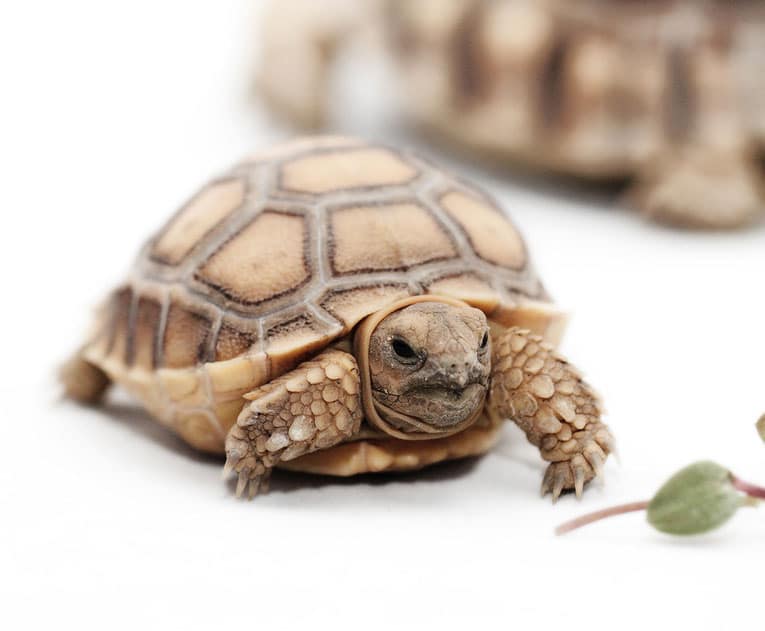
Also, other than shade, don’t forget to also provide a place where they may be exposed to sunlight for their outdoor shelter. UVB is important for these tortoises as it is a source of vitamin D3 which helps in their shell’s growth. Aside from light and warmth, water should be readily available to these tortoises. Having a water bowl at a corner of their shelter will help them keep hydrated.
Take note that this water bowl should be the right size, it should be shallow enough so that they won’t end up climbing in it. For the base of their shelter, having a mixture of both sand and soil is recommended. Moreover, even though the humidity levels in a sulcata tortoise’s natural habitat can be very high, they are actually used to lower levels of humidity as they spend much of their time in burrows to cool down.
You can do it DIY (Do-It-Yourself) or ask the assistance of someone else more skilled when it comes to building your shelter. Just make sure that important conditions are met to ensure that your pet will be at ease with its new home. If you want to learn more about the details of setting up a house for your pet, you may check Sulcata Station for an even more extensive view of the tortoise habitat that you intend to build.
Sulcata Tortoise Care – Giving Your Pet the Proper Attention
When you first purchase a sulcata tortoise, caring for it may not be much of a problem. However, as the years goes by, you’ll find how it can get way bigger than you might have imagined. Well, that is to be expected since they are among the biggest for the species. In fact, they are the third largest of all tortoises.
As a pet owner, giving your pet the proper care and attention is important to ascertain that they are healthy and turn out to be good pets. However, it can come as a challenge, especially to new pet owners. Hence, the best thing to do is to learn some tips and tricks that will surely make your pet ownership a fun and exciting one.
Sulcata tortoises are native to the southern part of the Sahara Desert. Given that, it is easy to infer that these animals need to be housed in dry and hot areas with an abundance of natural sunlight. Hence, when you are going to set-up your pet’s home, make sure to remember the species’ natural needs for its abode. However, this does not mean that they are used to extremely warm conditions. In their natural habitat, they burrow into the ground whenever temperatures become unbearable. In this manner, they can find areas with higher moisture levels.
The suggested temperature levels for these animals would be from 75 to 85 degrees. It is suggested that your tortoise should be kept in an indoor housing facility when the temperature gets colder such as during the night time. When it gets much bigger, you might want to consider building a suitable home for your pet. The Sulcata Station has a section in their website which can help you with the construction of your pet’s home, just click this link for more information.
Moreover, keep in mind that light, especially UVB radiation from the sun, is important to keep these animals active. If they lack exposure from a UVB source, they will end up being sluggish. It is a part of their nature since they come from a place where sunlight is of abundance. If providing an everyday source of natural sunlight isn’t readily available, then you can purchase an artificial UVB light as an alternative.
Food is another important aspect of their care. In terms of their diet, these animals are known to be highly herbivorous. Thus, their diet must consist primarily of certain herbaceous plants and vegetables. Water is also needed. Hence, you should provide a saucer or bowl of water in their shelter to avoid them from being dehydrated. You can check our article about the sulcata tortoise diet for a more extensive reference.
Where to Buy a Sulcata Tortoise?
The prospect of having a new pet sure is exciting! Especially when it is something that is out of the ordinary. Such is the case when you are thinking of having a sulcata tortoise as a pet. These animals, which are natives of the dry lands of some parts of Africa, have made their way to the pet industry. Having one as a pet is indeed an interesting idea. It can be challenging too, considering how it is seemingly very uncommon. If you are planning to have a sulcata as an additional family member, where can you likely find one for sale? Well, read on to find out.
The purchase of sulcata tortoises as pets has been quite popular in the United States. They are usually available in pet stores. That being said, it is important for you, the prospective pet owner, to find out more about where they were found. Just like in any other form of animal trade, there is a possibility that the animals were not provided with due care.
You might be wondering about why this would be important. If any animal has not received proper attention and care, they can develop physical and mental health issues. Dealing with these will certainly be difficult for the pet owner in the long run. Thus, if ever you find yourself purchasing a sulcata tortoise, do ask the sellers where their animals come from and how they are raised.
Aside from the traditional buying of this species in pet stores, the advent of new technology has also allowed them to be sold online. There are dozens of websites around that will let you purchase a sulcata tortoise from where you are sitting right now. Just remember that reading reviews about the site would be helpful for you to be assured that they have a good standing in the business. Some websites that you can check are as follows: BackwaterReptiles.com and TheTurtleSource.com.
Did you know that aside from looking for one at a pet store or online, it is even better to acquire one through rescuing? Yes, you read that right! Even these creatures also have rescue groups. Through adopting and rescuing a sulcata, you give the animal a chance to have a new home. The website Tortoise.com is dedicate to their mission of enlightening us about the rescue of these animals.
Sulcata Tortoise – Facts and Information
Our world is blessed with life forms that are so diverse. Across the vast stretches of land and seas live different life forms that are astounding in their own ways. The range of such species is truly immense. Both our earth’s flora and fauna are marvels to behold. Out of all these living forms, the ones who have walked our earth for centuries are the tortoises.
When I say centuries, I really mean it! They can live to be over a hundred years old and can be very big once they reach adulthood. Out of all these, the sulcata (also known as the African spurred) is known to be the third largest (next to the Galapagos and Aldabra giant).
Before we proceed any further, it would be great to distinguish what a tortoise is from a turtle. Using these two terms can be really confusing and some of us might even use it interchangeably. Well, the fact of the matter is that a tortoise falls under the category of turtles.
It is apparent how both of them are reptiles and have shells to protect their bodies. While there are a number of differences between the two, one of the easiest to distinguish is how tortoises are not much of water dwellers such as turtles. Generally, tortoises prefer to be in dry areas while turtles mostly live in water. So, there you have it – a major distinction between the two.
Despite the fact that these creatures will indeed become huge when fully grown, they have been made available to prospective pet owners. If you are one of those who plan to have one as a pet, then learning more information about them will help you understand their nature. Here are some facts:
Habitat
From the name of the African spurred, it is easy to tell that they are native to the African continent. They can particularly be found in the Sahara Desert, and in countries across the continent including Ethiopia, Sudan, Nigeria, Mali, and Mauritania among many others. Their natural habitats are grasslands, savannahs, and shrublands. They are known to burrow into the ground of these dry lands so that they may find moist areas and escape high temperatures.
In fact, their burrowing ability is quite remarkable and they have been referred to as little bulldozers due to this ability. When placed in captivity, there are some notes that should be remembered to assure that these animals remain away from health risks.
They must be kept in similar conditions just like in their natural habitat. That is, they must be kept in a dry and hot environment and avoid being in cold and damp temperatures. When it rains or if the nights turn out to be too cold, they can be placed indoors in temporary housing set-ups.
Diet
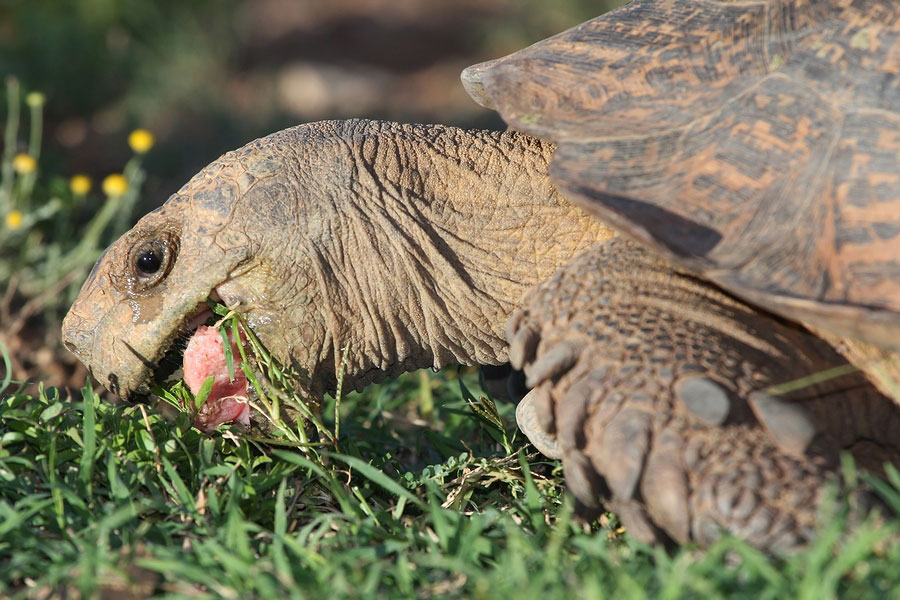
Being herbivores, the diet of a tortoise constitutes mostly of vegetables, grasses and other herbaceous plants. Their diet is another subject matter that should be discussed thoroughly due to its complexity. Hence, we came up with a separate article that can help you look into the matter further.
Lifespan
It is widely known that these creatures have a lengthy lifespan. They can live for over a century. In the case of the sulcata tortoise variety, they are expected to have a lifespan of about 50 to 150 years. Well, that means that some of them alive today have been around since the latter part of the 19th century! Now that’s one amazing feat.
Size
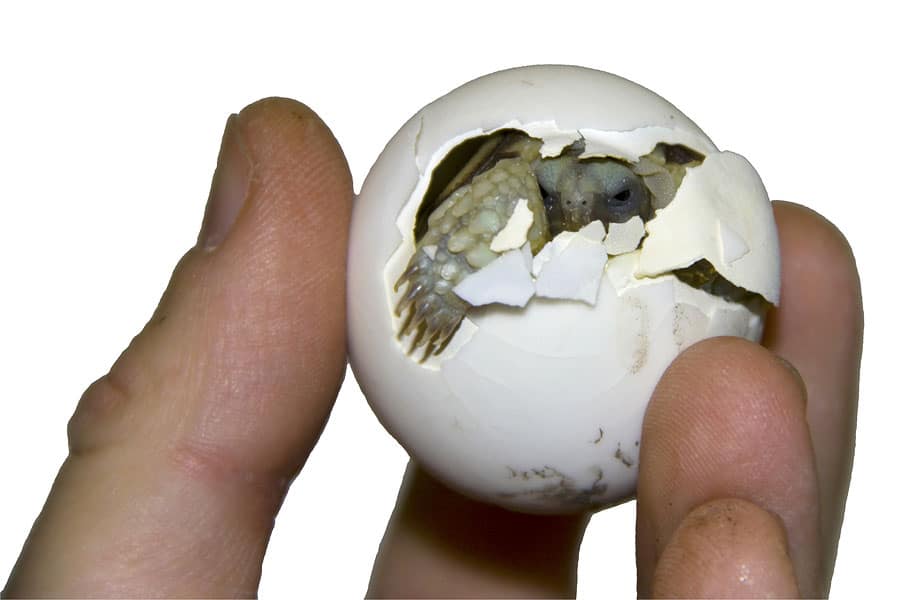
As hatchlings, they are barely 3 inches in length and you might be in for a surprise as they get older. Being the third largest out of all the species, you can expect the African spurred tortoise to get really big when fully grown. In average, they can weigh up to 200 lbs and be 24 to 36 inches long. Hence, necessary adjustments should be made to its housing and caging as they grow older. However, don’t worry too much about that while they are young since it will take time for them to become massive in size.
People who consider having one as a pet should be responsible enough to understand the nature of these animals. In this manner, they can be assured that the tortoise can be healthy and reach its expected lifespan. Providing them with the proper diet and care are keys so they can enjoy a healthy life.
Things Pet Owners Must Know About Sulcata Tortoise
For those who are interested in owning Sulcata tortoise, there are a few things that must be considered before one makes a decision. Since this kind of creature has a long lifespan much longer than humans have, much attention is needed in making these creatures even healthier and thus, people will have a more time to spend with them.
Although baby sulcata are adorable and are very small and can easily fit into one’s hand, they will eventually get big a lot bigger. Sulcatas are the third largest types of tortoises across the world. The species and Aldabra and Galapagos tortoises are the only big tortoises that can be usually seen in zoos across the world.
An average sulcata tortoise can grow as much as 18 inches or 45 cm with the length of their shell or around 70 to 100 pounds or 30 to 45 kg of weight. Several tortoises can get even larger depending on certain species.
Sulcata tortoise can also grow quickly. Like a desert species of tortoises, they can develop to cope with sparse and erratic supplies of food. If in captivity, as a form of response to regular and abundant food supplies, sulcata tortoise have a tendency to grow very fast, so they really reach their adult size within just five or about 10 years, unlike their relatives in the wild that it takes around 20 to 50 to reach their mature size. This reality attracts many aspirant owners very interested, considering that most pet shop staffs more often than not tell possible buyers to grab one and bring them home.
Generally, tortoises are good companions especially for those who are interested in having slow but big and gentle animals in their lawn. One of the best qualities is their friendliness and sluggishness. But these qualities seemed not to attract most people. For some, a too slow animal is not totally attractive and appealing creature for some.
Shelter and Housing
Most people erroneously think that tortoises particularly sulcata tortoise, should be placed at hotter areas since they’re desert animals. This isn’t the case after all. Once the temperature decreases below 85 degrees F. Sulcatas will really look for shelter in the heat within their underground burrows, and they’ll stay underground right up until temperatures drops to bearable levels. Tortoises in the wild avoid the mid-day sun as well as heat, and only coming above-ground to enjoy and drink fresh water in the morning or in later day just after the temperatures starts to drop.
Be sure your tortoise can access cooler places or shade in order that it can cool off at the appropriate time. Evening temperatures needs to be below the day temperatures, but must not be allowed to fall below 60 degrees.
Health
At some time, the sulcata tortoise will grow big enough that it’ll be bothersome to keep them indoors. During these moments, you will have to build a well heated, safe tortoise shed that will serve as being the tortoise’s home at night.
Since they’re from the semi-arid, very sunny surroundings, sulcatas need a lot of light to keep active and healthy; without substantial light amounts, these animals may become lethargic. Sulcata also needs to be exposes to UVB light to enable them to generate proper amounts of Vitamin D3 within their bodies.
The Vitamin D3 is important for the efficient metabolism of varied nutrients and chemicals in their body such as calcium from the food they eat– tortoises that are lacking the enough amounts of Vitamin D3 can’t develop healthy bones as well as shells, regardless of how much calcium these animal eat in a regular basis.
Additionally, sunlight could be the single best supply of UVB radiation, therefore, the best and most secure method to supply Vitamin D3 for a tortoise would be to let it go outside and stay exposed to the sun not less than 20 minutes each day. If this isn’t possible in your area, then you should supply the tortoise with the synthetic UVB light supply as an alternative.
Efficient Sulcata Tortoise Care
A Sulcata Tortoise can make delightful pets as they are not demanding but they do need care and have certain necessities. Young ones must be kept indoors for some years to keep them safe from birds, cats and dogs. There are certain things that should be kept in mind to keep your pet healthy when they are retained indoors till they are big enough to go out.
A plastic tub, trough or a glass aquarium can be used to house a young tortoise. A layer of dirt, alfalfa or aspen pellets could be used. They live on dirt in the wild; they are used to it, so just make sure the dirt is free of any pesticides or any other impurities. Make sure the enclosure is large enough for the animal to walk around and reconnoiter the area.
Hallowed out wooden logs can be provided to them for hideouts. They are used to humid environments as their homes are underground burrows where they spend most of their time. Staying indoors might give them a dried environment and are likely to suffer from shell pyramiding. The wooden log provided for their shelter should be wet in water at least twice a week to solve their humidity problems.
The growing sulcata tortoise needs UV light for proper growth and development. A fluorescent bulb, which could be anywhere from 18 to 48 inches needs to be placed not more than 24 inches above the ground where the enclosure is placed. An additional lamp to provide heat is also required. Both these lightings should not be blocked by anything else, as the tortoise would not get any benefit from the lights and heat. Time and again they should be taken out for natural sunlight, as well.
Grass and hay are the best diets for your tortoise. You could also feed it fruits, however keep them for occasional treats only. You can give them a shallow water bath once a week for 20-30 minutes; remember to soak them to their chin only. You can dust the greens twice a week with a calcium powder without Vitamin D3 or once a week with multivitamin powder for reptiles.
You should take them once a year to the vet to ensure they are growing healthy and normally.
An adult sulcata’s enclosure should be made of sod – you can use a mix of rye, fescue and Bermuda grass. They love to graze throughout the day. Sulcatas kept outdoors are healthier than the ones kept indoors as they get a lot of nutrition from hibiscus leaves, prickly pears, cactus pads, and other leaves that provide them with necessary nutrients.
This species can live for decades and will bond with their owners if kept properly. Many will outgrow their owners; make sure you find friends and relatives who will take care of them if you are unable to give them proper attention.
Unique Sulcata Tortoise Diet
Great nutrition for pets are crucial to preserve optimum health. Understanding what meals for sulcata tortoise diet demands some knowledge of what particular requirements your specific type of animal demands.
Most types of these tortoises are usually herbivores. However, this doesn’t imply you are able to just make do with feeding him a couple of limp lettuce simply leaves and the irregular tomato. You will find eight components to great nutritional health. They will consist of, water, proteins, carbohydrate food, fats, fibers, digestive enzymes, minerals and vitamins. All function with each other to stop illness as well as market development.
Numerous producers who create meals for these tortoises may claim that they complement their feed with important minerals and vitamins but you need to also offer fresh plants and infrequent fruit anytime feasible. Not only will this diet plan be healthier, it will likely be much more fascinating for the pet.
A couple of fresh vegetables you can select are broccoli, spinach, or perhaps kale. On the other hand, some options of fruits are peeled banana, apple, blackberries, as well as blueberries.
Tortoises tend to be herbivores and in the event you do some study into exactly where within the all-natural community your type of tortoise would usually reside, this may provide you with a concept of what kind of foods to supply.
Be cautious to not feed the tortoise plants in the cabbage family too often as they interfere with the thyroid functionality and calcium consumption. They’re a great supply of nutrition but merely give them small amounts every few weeks or so.
When you have a species that naturally resides in arid grass, they’ll appreciate grazing in grasses, weed growth, and moist plants. The sulcata tortoise likes hay as well as cactus, and a number of succulent fruit and grated vegetables.
It isn’t tough to supply a nourishing and fascinating diet plan for your pet. It simply requires a bit of preparation. You can research and plan some more fresh vegetables and plants for the animal to eat.
They’ll appreciate feeling as if they’re within their wild all-natural atmosphere and this may assist them to help keep mentally wholesome and physically fit.
Specially produced meals which you are able to purchase through pet shops will probably be sufficient because they generally have minerals and vitamins added. However, the very best meals for a tortoise’s health is a combination of this plus all-natural and fresh vegetables, as well as fruit.

Having discovered a fondness for insects while pursuing her degree in Biology, Randi Jones was quite bugged to know that people usually dismissed these little creatures as “creepy-crawlies”.

